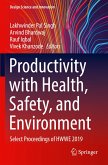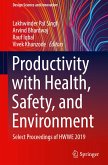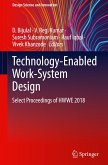Ergonomics in Caring for People
Proceedings of the International Conference on Humanizing Work and Work Environment 2015
Herausgegeben:Ray, Gaur G.; Iqbal, Rauf; Ganguli, Anindya K.; Khanzode, Vivek
Ergonomics in Caring for People
Proceedings of the International Conference on Humanizing Work and Work Environment 2015
Herausgegeben:Ray, Gaur G.; Iqbal, Rauf; Ganguli, Anindya K.; Khanzode, Vivek
- Broschiertes Buch
- Merkliste
- Auf die Merkliste
- Bewerten Bewerten
- Teilen
- Produkt teilen
- Produkterinnerung
- Produkterinnerung
This volume comprises select proceedings of the International Conference on Humanizing Work and Work Environment organized by the Indian Society of Ergonomics. The book presents research findings on different areas of ergonomics for developing appropriate tools and work environment considering capabilities and limitations of working people for maximum effectiveness on their performance. The volume is divided into several sections focusing on different ergonomic research activities currently being undertaken at both national and international levels. Considering the high diversity among…mehr
Andere Kunden interessierten sich auch für
![Productivity with Health, Safety, and Environment Productivity with Health, Safety, and Environment]() Productivity with Health, Safety, and Environment145,99 €
Productivity with Health, Safety, and Environment145,99 €![Productivity with Health, Safety, and Environment Productivity with Health, Safety, and Environment]() Productivity with Health, Safety, and Environment137,99 €
Productivity with Health, Safety, and Environment137,99 €![Technology-Enabled Work-System Design Technology-Enabled Work-System Design]() Technology-Enabled Work-System Design150,99 €
Technology-Enabled Work-System Design150,99 €![Technology-Enabled Work-System Design Technology-Enabled Work-System Design]() Technology-Enabled Work-System Design145,99 €
Technology-Enabled Work-System Design145,99 €![Occupational and Environmental Safety and Health Occupational and Environmental Safety and Health]() Occupational and Environmental Safety and Health226,99 €
Occupational and Environmental Safety and Health226,99 €![Occupational and Environmental Safety and Health II Occupational and Environmental Safety and Health II]() Occupational and Environmental Safety and Health II202,99 €
Occupational and Environmental Safety and Health II202,99 €![Occupational and Environmental Safety and Health II Occupational and Environmental Safety and Health II]() Occupational and Environmental Safety and Health II267,49 €
Occupational and Environmental Safety and Health II267,49 €-
-
-
This volume comprises select proceedings of the International Conference on Humanizing Work and Work Environment organized by the Indian Society of Ergonomics. The book presents research findings on different areas of ergonomics for developing appropriate tools and work environment considering capabilities and limitations of working people for maximum effectiveness on their performance. The volume is divided into several sections focusing on different ergonomic research activities currently being undertaken at both national and international levels. Considering the high diversity among researchers contributing to this volume, it should prove to be a valuable collection of different approaches that contemporary researchers are adopting on the theme of caring for the people and humanizing work and work environment.
Produktdetails
- Produktdetails
- Verlag: Springer / Springer Nature Singapore / Springer, Berlin
- Artikelnr. des Verlages: 978-981-13-5283-6
- Softcover reprint of the original 1st ed. 2018
- Seitenzahl: 384
- Erscheinungstermin: 23. Dezember 2018
- Englisch
- Abmessung: 235mm x 155mm x 20mm
- Gewicht: 698g
- ISBN-13: 9789811352836
- ISBN-10: 9811352836
- Artikelnr.: 54773467
- Herstellerkennzeichnung
- Books on Demand GmbH
- In de Tarpen 42
- 22848 Norderstedt
- info@bod.de
- 040 53433511
- Verlag: Springer / Springer Nature Singapore / Springer, Berlin
- Artikelnr. des Verlages: 978-981-13-5283-6
- Softcover reprint of the original 1st ed. 2018
- Seitenzahl: 384
- Erscheinungstermin: 23. Dezember 2018
- Englisch
- Abmessung: 235mm x 155mm x 20mm
- Gewicht: 698g
- ISBN-13: 9789811352836
- ISBN-10: 9811352836
- Artikelnr.: 54773467
- Herstellerkennzeichnung
- Books on Demand GmbH
- In de Tarpen 42
- 22848 Norderstedt
- info@bod.de
- 040 53433511
Professor Gaur G. Ray is currently appointed as the Ramkrishna Bajaj Chair Professor of the Industrial Design Centre (IDC) at the Indian Institute of Technology Bombay (IITB). He recently got superannuated and been offered the 'Professor Emeritus Fellowship' Position by IITB from July, 2017. He was also the Head of the Department from 2009 to 2013 and responsible as the Head of the Ergonomics program of the institute. His past roles includes being appointed as Visiting Faculty at the Department of Engineering Design, Tufts University, USA, Department of Human Work Sciences, Lulea University of Technology, Sweden, and several other Universities. He was the founder member and served as the Honorary President of the Indian Society of Ergonomics for about ten years and also was the Chairperson of the Ergonomics Section (PG 15), Bureau of Indian Standard, for nine years. Professor Gaur G. Ray has also been involved in a number of international relations development projects includingresearch collaborations between the Industrial Design Centre (IDC) at IITB and the Institute of Ergonomics (IAD) at TU Darmstadt in Germany and other Universities. His major activities are in the areas on application of ergonomics in product development, for the people at the bottom of the pyramid, agriculture sector, geriatric population, automotive industry and design for the special people. He has published more than 30 papers in International Journals, Presented more than 130 papers in different national and International conferences, completed more that 15 funded project by DST, MHRD, AICTE and other organisations, completed more than 8 major consultation projects starting from vehicle design, workstation design, low cost agricultural tools design, etc. He recently completed the entire driver's cabin design, layout, control panel organisation, and chair design for Mumbai Railway Vikas Limited. He has been awarded "J.N.Maitra" Gold Medal in the year 1998 by the Physiological Society of India for contribution in Indian Ergonomics. He was invited as Keynote Speaker by the International Ergonomics Association in 2015 at Melbourne. He has also received several best paper awards in the International and International conferences. In the year 2014 he received the Ramkrishna Bajaj Chair Professor Fellowship Award from IITB for three years. Professor Ray has guided seven Ph.Ds, more than 20 M.Des projects, and several M.Tech and M.Sc. projects. He has published two books, edited 2 conference proceedings, and obtained three National patents. He has applied for one International patent in the area of product design. Prof. Ray is attached with several International and National Publishers as a referee. He is also member of the International Development Standing Committee of the International Ergonomics Association. The Concept of creating HWWE platform in India is his brain child and the first HWWE conference was hosted at IDC, IITB, in the year 2001 under his secretariat. Dr. Rauf Iqbal, Associate Professor - Ergonomics and Human Factors Engineering, Prof. In-Charge-Ergonomics Laboratory, Coordinator-Mind to Market Centre, National Institute of Industrial Engineering (NITIE). His academic qualification is M.Sc. in Ergonomics & Work Physiology (Topper, Gold Medalist, Calcutta University) and Ph.D. His area of expertise is Ergonomics & Human Factors Engineering and Work system design. He has published 39 papers in International and National Journals including book chapter. He has presented 57 papers in International and national conferences. Five scholars have been awarded P.hD. and five more are currently pursuing their P.hD under the guidance of Prof. Rauf Iqbal. He is the paper reviewer of i)'Journal of Back and Musculoskeletal Rehabilitation', published by Roessingh Research and Development, Netherlands. ii) 'Journal of Sports Sciences', published by Taylor and Francis group on behalf of the British Association of Sport and Exercise Sciences, UK. iii) 'Indian Journal of Biological Sciences' published by Vidyasagar University, West Bengal and iv) International Journal of Health Science and wellbeing', Nigeria. He is the member various national and international committees like, member of the Technical Committee for Prime Minister's Shram Awards for the year 2015. Member of Tripartite Awards Committee of Vishwakarma Rashtriya Puraskar (VRP) and National Safety Awards (NSA) by the Ministry of Labour and Employment, Govt. of India, since 2014; member of BRICSplus liaison Sub-Committee for collaborative work (training, research and conference) on ergonomics among BRICS countries; International Editorial Board member of Journal of Health and Safety at work, published by Tehran University Medical Journal publisher; member of Research Progress Committee, external expert and member of Internal Quality Assurance Cell of SNDT Women's University, Mumbai etc. He has Conducted 10 sponsored projects / National studies and more than 50 industrial consultancy studies in the area of Ergonomics, Work-study and manpower optimization. Recently he has been involved in "Redesigning the palanquin system for use in Mata Vaishno Devi Shrine", funded by the office of the Principal Scientific Advisor to Govt. of India, New Delhi. He is involved in collaborative research and consultancy with various Industries and Institutes in the area of ergonomics, product and worksystem design. He has been organizing conferences and seminars at National and International level. Dr. A.K.Ganguli was born and educated in Calcutta. After graduating from Presidency College, Calcutta, in 1975, he completed his post-graduate studies in Physiology (with specialisation in Work Physiology & Ergonomics) from Calcutta University in 1977, and undertook research in the Ergonomics Laboratory of the Dept. of Physiology, Calcutta University under the renowned Prof.R.N.Sen. In 1983, he joined the Occupational Health Service of the Bharat Heavy Electricals Ltd., Tiruchirapalli, as the first ever in-house ergonomist in Indian industry, ultimately heading the Work Physiology & Ergonomics unit there. He grew with the organization in its Occupational Health and Safety journey till his retirement as a Senior Deputy General Manager in 2014. He is a Lead Assessor for the Occupational Health & Safety Management System Standard (OHSAS 18001), and Environment Management System Standard (ISO 14001), and has undertaken numerous ergonomics consultancy assignments in different industries. He is the Chairman of the Sectional Committee on Ergonomics Standards (PGD-15) of the Bureau of Indian Standards (BIS). He served as faculty in Ergonomics for the M.E. (Industrial Safety Engineering) course at the National Institute of Technology (Formerly REC), Tiruchirappalli, and as visiting faculty for the M.Des. course at the Industrial Design Centre, I.I.T, Bombay. He has published thirty scientific papers, (including twelvein foreign journals), has contributed to four books. He has received the BEL-IND award for the Best Research Paper in Industrial Medicine, and the Sadagopan Memorial Oration award. Currently, he is a member of the Human Factors and Ergonomics Society (USA), and the President of the Indian Society of Ergonomics. Vivek Khanzode is Associate Professor at National Institute of Industrial Engineering, Mumbai. His academic credentials include Bachelor's degree in Mechanical Engineering from Walchand College of Engineering, Sangli, and MTech and PhD in Industrial Engineering from IIT Kharagpur. He has been recipient of Director's Silver Medal at MTech program in IIT Kharagpur. He has 5¿ years of industrial experience and 14 years of academic experience. He has helped various organizations including several small-scale units to improve productivity using industrial engineering tools and techniques. He regularly conducts niche training programs in the areas of industrial engineering, worksystem design, lean manufacturing, and industrial safety management for practitioners and academicians. He is also involved in collaborative research activities in these areas. Prof Khanzode has published 13 papers in international journals, and presented 23 papers in international and national conferences. One scholar has been awarded PhD under the guidance of Prof Khanzode and four more are pursuing doctoral research. Three of his papers are included in the ILO database of Hazard and Injury Risk Assessment. Currently he has been involved in redesigning the palanquin system for Mata Vaishno Devi Shrine, a NITIE-IIT Bombay joint project funded by the Office of the Principal Scientific Advisor, Govt. of India, New Delhi. Prof Khanzode teaches Operations Management, Lean Manufacturing, Simulation Modeling, Facilities and Layout Planning, and Worksystem Design in different postgraduate programs at NITIE.
PART I: Biomechanics.- Chapter 1: Impact of Footwear on Gait Pattern.- Chapter 2: Characteristics of Gait Variability Among Healthy Indian Construction Workers during Different Load Carrying Modes.- PART II: Musculo Skeletal Disorders.- Chapter 3: A Study on Agony of Indian Percussionists.- Chapter 4: Prevalence of Upper-Limb Disorders and investigation of Risk Factors Among Commercial Kitchen Male Workers in South India.- Chapter 5: Effect of Occupational Factors on Musculoskeletal Disorders of the insurance office Employees: A Case Study.- Chapter 6: Assessment of forearm Muscle Work in Various Dental Activities.- Chapter 7: Investigation of Magnitude of Musculoskeletal Disorders Among Cotton Spinning Operators.- Chapter 8: Working Period, Year of Exposure and the Prevalence of Musculoskeletal Disorders Among the Saw Mill Workers: A Cross Sectional Study.- Chapter 9: Duration of Exposure (Working Hours) and Musculoskeletal Discomfort/Pain.- PART III: Health & Safety.- Chapter 10: Knowledge-Attitude-Practice (Kap) Study and Nutrition Education of Athletic and Non-Athletic Teenagers (13-18 Years).- Chapter 11: A Study on Auditory Status of School Going Children Residing Near Railway Track.- Chapter 12: Assessment of Scapular Stability in Postpartum Females -A Longitudinal Study.- Chapter 13: General Health Related Physical Fitness Levels of College Going Girls from Maharashtra.- Chapter 14: Bagasse -A Replacement of Glass Wool as an Acoustic Material.- PART IV: Occupational Ergonomics.- Chapter 15: Manual Material Handling by Rural Women: An in-depth Analysis of the Body Pain Areas.- Chapter 16: Characterization of Drudgery of Farm Women in the Soybean Production System.- Chapter 17: Association of Job and Demographical Risk Factors with Occurrence of Neck Pain Among Hand Screen PrInting Workers.- Chapter 18: Effect of Fatigue on Hand Function in Dental Profession.- Chapter 19: Cardiac Stress Among Two Types of Handloom Weavers.- Chapter 20: Workspace Amenities for Assam Policewomen: Ergonomic Interventions.- Chapter 21: Physiological and Metabolic Status of Bus Drivers.- Chapter 22: Effectiveness of a Participatory Ergonomics Intervention to Improve Musculoskeletal Health: A Solomon Four-Group Study Among Manufacturing Industry Workers in Selangor, Malaysia.- PART V: Design Ergonomics.- Chapter 23: Ergonomic Intervention for Manual Harvesting in Agriculture: A Review.- Chapter 24: Skin-Bed Interface Pressure on Standard Hospital Mattress for Sitting, Prone and Supine Posture in Healthy Adults.- Chapter 25: Designing a Continuously Variable Transmission Mechanism for Economy Cars in India.- Chapter 26: A Brief Procedure for Ergonomic Design of Hand tool for Small Scale Industries.- Chapter 27: Designing Washroom for Wheelchair Users in Vocational Training Schools.- Chapter 28: Intra and Inter Reliability of Cervical Goniometer Used to Measure Cervical Range of Motion in Young Adults.- PART VI: User Experience.- Chapter 29: Number Plate Design for Bicycles: An Approach from Aesthetic and Ergonomic Perspective.- Chapter 30: Anthropomorphic Televisions are more Attractive: The Effect of Novelty.- Chapter 31: Identification of Aesthetically Favorable Interface Attributes for Better User Experience of Social Networking Application.- Chapter 32: Exploring Embedded Intelligence as a means of Minimizing Cognitive Load of Students in Electronics Engineering Instructional Laboratory Sessions.- Chapter 33: Product User Interfaces: A Study for the Meaning and Usability of Graphical User Interfaces in Indian Context.- Chapter 34: Effect of Baby-Like Product Personality on Visually Perceived Pleasure: A Case Study on Coffee Makers.- Chapter 35: Quantitative Probabilistic Widgets' as a method to improve Usability Performance of Data Entry Tasks.- PART VII: Cognitive Ergonomics.- Chapter 36: An Eye-Free Android Application for Visually Impaired Users.- Chapter 37: Meditation as a Countermeasure to Reduce Cognitive Decline during total Sleep Deprivation.- Chapter 38: Effects of Bharatnatyam Dancing on the Cognitive Ability of Adult Bengalee Females.- Chapter 39: A Cognitive Approach to Design of Habitats in Extraterrestrial Environments: Review of Literature.- Chapter 40: Mental Fatigue Quantification by Physiological and Neurophysiological Techniques: An Overview.- Chapter 41: Role of Language in Transfer of Tacit Knowledge: Case Study of Bamboo Crafts Making industries in North East India.- Chapter 42: Study of Visual Ergonomic Issues in Title Design in Popular Hindi Cinema Posters.- Chapter 43: Research in Driver-Vehicle Interaction: Indian Scenario.
PART I: Biomechanics.- Chapter 1: Impact of Footwear on Gait Pattern.- Chapter 2: Characteristics of Gait Variability Among Healthy Indian Construction Workers during Different Load Carrying Modes.- PART II: Musculo Skeletal Disorders.- Chapter 3: A Study on Agony of Indian Percussionists.- Chapter 4: Prevalence of Upper-Limb Disorders and investigation of Risk Factors Among Commercial Kitchen Male Workers in South India.- Chapter 5: Effect of Occupational Factors on Musculoskeletal Disorders of the insurance office Employees: A Case Study.- Chapter 6: Assessment of forearm Muscle Work in Various Dental Activities.- Chapter 7: Investigation of Magnitude of Musculoskeletal Disorders Among Cotton Spinning Operators.- Chapter 8: Working Period, Year of Exposure and the Prevalence of Musculoskeletal Disorders Among the Saw Mill Workers: A Cross Sectional Study.- Chapter 9: Duration of Exposure (Working Hours) and Musculoskeletal Discomfort/Pain.- PART III: Health & Safety.- Chapter 10: Knowledge-Attitude-Practice (Kap) Study and Nutrition Education of Athletic and Non-Athletic Teenagers (13-18 Years).- Chapter 11: A Study on Auditory Status of School Going Children Residing Near Railway Track.- Chapter 12: Assessment of Scapular Stability in Postpartum Females -A Longitudinal Study.- Chapter 13: General Health Related Physical Fitness Levels of College Going Girls from Maharashtra.- Chapter 14: Bagasse -A Replacement of Glass Wool as an Acoustic Material.- PART IV: Occupational Ergonomics.- Chapter 15: Manual Material Handling by Rural Women: An in-depth Analysis of the Body Pain Areas.- Chapter 16: Characterization of Drudgery of Farm Women in the Soybean Production System.- Chapter 17: Association of Job and Demographical Risk Factors with Occurrence of Neck Pain Among Hand Screen PrInting Workers.- Chapter 18: Effect of Fatigue on Hand Function in Dental Profession.- Chapter 19: Cardiac Stress Among Two Types of Handloom Weavers.- Chapter 20: Workspace Amenities for Assam Policewomen: Ergonomic Interventions.- Chapter 21: Physiological and Metabolic Status of Bus Drivers.- Chapter 22: Effectiveness of a Participatory Ergonomics Intervention to Improve Musculoskeletal Health: A Solomon Four-Group Study Among Manufacturing Industry Workers in Selangor, Malaysia.- PART V: Design Ergonomics.- Chapter 23: Ergonomic Intervention for Manual Harvesting in Agriculture: A Review.- Chapter 24: Skin-Bed Interface Pressure on Standard Hospital Mattress for Sitting, Prone and Supine Posture in Healthy Adults.- Chapter 25: Designing a Continuously Variable Transmission Mechanism for Economy Cars in India.- Chapter 26: A Brief Procedure for Ergonomic Design of Hand tool for Small Scale Industries.- Chapter 27: Designing Washroom for Wheelchair Users in Vocational Training Schools.- Chapter 28: Intra and Inter Reliability of Cervical Goniometer Used to Measure Cervical Range of Motion in Young Adults.- PART VI: User Experience.- Chapter 29: Number Plate Design for Bicycles: An Approach from Aesthetic and Ergonomic Perspective.- Chapter 30: Anthropomorphic Televisions are more Attractive: The Effect of Novelty.- Chapter 31: Identification of Aesthetically Favorable Interface Attributes for Better User Experience of Social Networking Application.- Chapter 32: Exploring Embedded Intelligence as a means of Minimizing Cognitive Load of Students in Electronics Engineering Instructional Laboratory Sessions.- Chapter 33: Product User Interfaces: A Study for the Meaning and Usability of Graphical User Interfaces in Indian Context.- Chapter 34: Effect of Baby-Like Product Personality on Visually Perceived Pleasure: A Case Study on Coffee Makers.- Chapter 35: Quantitative Probabilistic Widgets' as a method to improve Usability Performance of Data Entry Tasks.- PART VII: Cognitive Ergonomics.- Chapter 36: An Eye-Free Android Application for Visually Impaired Users.- Chapter 37: Meditation as a Countermeasure to Reduce Cognitive Decline during total Sleep Deprivation.- Chapter 38: Effects of Bharatnatyam Dancing on the Cognitive Ability of Adult Bengalee Females.- Chapter 39: A Cognitive Approach to Design of Habitats in Extraterrestrial Environments: Review of Literature.- Chapter 40: Mental Fatigue Quantification by Physiological and Neurophysiological Techniques: An Overview.- Chapter 41: Role of Language in Transfer of Tacit Knowledge: Case Study of Bamboo Crafts Making industries in North East India.- Chapter 42: Study of Visual Ergonomic Issues in Title Design in Popular Hindi Cinema Posters.- Chapter 43: Research in Driver-Vehicle Interaction: Indian Scenario.








